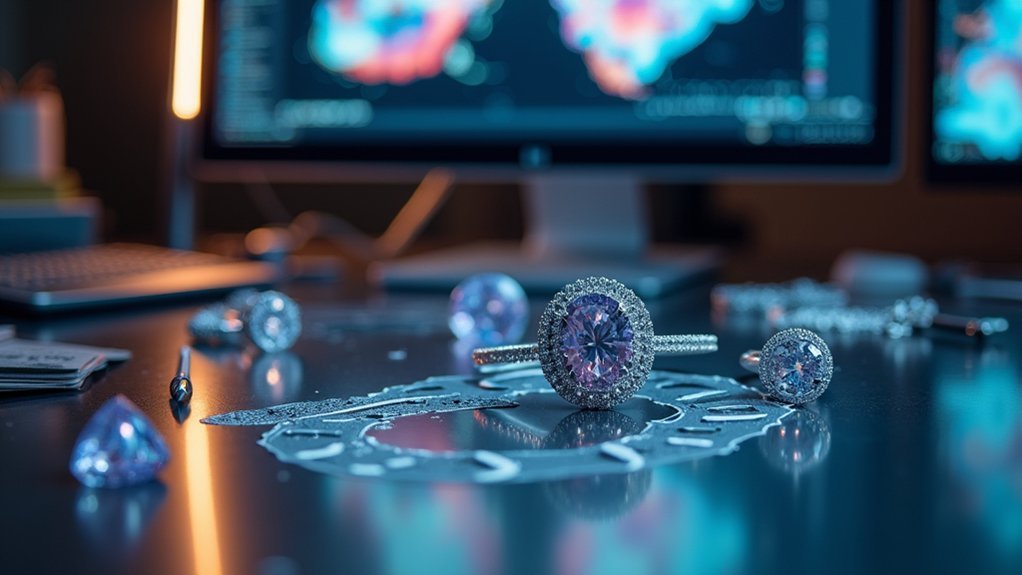You can pursue jewelry CAD certification through programs like Stuller’s two-week intensive course, which covers essential software like Rhino 3D, MatrixGold, and 3Design. You’ll master 3D modeling, digital rendering, and manufacturing processes while learning to create manufacturable designs that combine artistic vision with technical expertise. Training is available both in-person and virtually, requiring only a laptop with CAD software and a 90-day evaluation license. This certification opens doors to roles from CAD technician to senior design consultant, plus freelance opportunities across the jewelry industry from custom boutiques to luxury manufacturers.
Understanding CAD Software Options for Jewelry Design

When you’re starting your journey into jewelry CAD, selecting the right software becomes one of your most essential decisions.
Three major CAD software options dominate jewellery design: Rhino 3D, MatrixGold, and 3Design.
Rhino 3D offers exceptional versatility and robust modeling capabilities, making it perfect whether you’re a beginner or experienced designer. Its extensive toolset adapts to various design challenges you’ll encounter in Jewellery CAD.
MatrixGold combines design and manufacturing tools seamlessly, allowing you to create intricate models while streamlining your production process. This integration saves valuable time during project development.
3Design stands out with its user-friendly interface and powerful rendering capabilities. You’ll create photorealistic images that showcase your designs professionally.
Understanding each software’s specific strengths and weaknesses will greatly enhance your workflow and output quality in the jewelry industry.
Career Opportunities in Jewelry CAD Technology
You’ll find diverse industry job roles available once you’ve earned your jewelry CAD certification, from CAD technician positions at design studios to product developer roles at major jewelry manufacturers.
These entry-level positions can quickly lead to specialized roles like CAD service bureau technician or senior design consultant as you gain experience.
Your professional growth path isn’t limited to traditional employment either—many certified CAD professionals establish successful freelance practices or launch their own jewelry design businesses.
Industry Job Roles
As the jewelry industry embraces digital transformation, you’ll discover a wealth of career opportunities that leverage CAD technology across various specialized roles.
You can pursue positions as a CAD Service Bureau Technician, where you’ll provide technical support and design services to multiple clients.
As a Jewelry CAD Technician, you’ll create detailed 3D models of pieces of jewelry using industry-standard software like Rhino 3D.
Product Developers combine CAD expertise with market knowledge to conceptualize and prototype innovative jewellery designs that align with current trends and manufacturing capabilities.
The growing demand for digital design professionals spans custom jewelry boutiques to luxury goods manufacturers, offering diverse pathways for career advancement in this evolving technological landscape.
Professional Growth Paths
While many professionals enter jewelry CAD as technicians, your career trajectory can expand dramatically through strategic skill development and industry networking.
You’ll start by mastering intricate 3D modeling and advanced CAD software, then progress toward specialized roles like Product Developer, where you’ll oversee entire design processes from initial sketches to final prototypes.
CAD Service Bureau Technician positions offer entrepreneurial opportunities, providing specialized services to jewelers without in-house capabilities.
Through extensive certification programs, you’ll gain versatile skills that open doors across design, production, and sales departments.
Industry networking events become essential for connecting with professionals who can accelerate your advancement.
Your digital design expertise positions you perfectly for the jewelry industry’s growing technological demands.
Essential Skills and Learning Objectives

Mastering jewelry CAD certification requires developing an extensive skill set that bridges traditional design principles with cutting-edge digital technology.
You’ll gain proficiency in 3D modeling using CAD software, enabling you to create detailed and manufacturable jewelry designs. Digital rendering skills become essential as you learn to produce photorealistic images that enhance presentation and marketing potential.
You’ll master computer-aided manufacturing processes, including 3D printing, understanding how digital designs translate into physical prototypes.
Applying CAD engineering parameters guarantees your jewelry pieces maintain durability and functionality. Best practices and professional techniques prevent costly remakes while improving design precision.
These learning objectives prepare you for real-world challenges, combining artistic vision with technical expertise to create commercially viable jewelry designs.
Certification Programs and Training Formats
Once you’ve identified your learning objectives, you’ll need to select the right certification program format that fits your schedule and learning style. You have two primary options: in-person or virtual training.
The hands-on, instructor-led in-person certification takes place at Stuller headquarters in Lafayette, LA. This intensive four-day program offers thorough curriculum with direct access to instructors and equipment.
If you can’t travel, the virtual certification option delivers high-quality instruction through Microsoft Teams or Zoom from your home. You’ll receive the same expert guidance without geographical constraints.
Both formats provide training manuals, ensuring you have detailed resources during and after certification.
Each program emphasizes practical skills and industry-applicable knowledge, preparing you for various jewelry CAD design career paths.
Course Duration, Costs, and Prerequisites

When you’re considering jewelry CAD certification, you’ll need to understand the time commitment, financial investment, and basic qualifications required.
Most programs offer intensive formats that can fit into your schedule while providing thorough training.
You’ll also want to guarantee you meet the technical prerequisites before enrolling in any certification course.
Program Length Options
Most jewelry CAD certification programs offer a structured two-week intensive format that balances thorough learning with practical application.
You’ll attend classes Monday through Thursday from 9 AM to 5 PM, giving you eight hours daily to master CAD techniques and jewelry design principles. Friday sessions run from 9 AM to 12:30 PM, providing a shorter day to wrap up weekly projects and review your progress.
This concentrated schedule allows you to immerse yourself fully in the material without dragging the learning process over months.
You’ll build momentum quickly, maintaining focus on complex 3D modeling concepts while developing practical skills you can immediately apply.
The intensive format guarantees you complete your certification efficiently, letting you enter the jewelry design field or advance your existing career within just two weeks.
Tuition and Fees
The complete Jewelry CAD certification program costs $2,950 for two weeks of intensive training that transforms beginners into skilled 3D jewelry designers. This all-inclusive fee covers thorough CAD techniques, jewelry design fundamentals, and ongoing support throughout your learning journey.
| Cost Component | Details |
|---|---|
| Total Tuition | $2,950 (complete program) |
| Training Duration | 2 weeks intensive |
| Support Included | Additional resources & guidance |
| Software Required | Rhino 3D (student provides) |
You’ll need to bring your own laptop with Rhino 3D software installed—preferably version 8 for PC. While basic computer literacy is required, you don’t need prior 3D modeling experience. The program includes all necessary training materials and additional resources to guarantee you successfully complete your certification.
Entry Requirements
Before enrolling in the jewelry CAD certification program, you’ll need to meet several straightforward requirements that confirm you’re prepared for success.
You must have basic computer literacy skills, though no prior 3D modeling experience is necessary. The program welcomes beginners and experienced designers alike.
You’ll need to bring a laptop equipped with the latest version of Rhino 3D software, which runs on both Windows and Mac systems.
If you don’t currently own this software, you can download a 90-day evaluation license from the McNeel website at no additional cost.
The course runs for two weeks with a structured schedule: Monday through Thursday from 9 AM to 5 PM, and Friday from 9 AM to 12:30 PM.
This intensive format guarantees thorough coverage.
Hands-On Training and Practical Applications

While theoretical knowledge forms the foundation of jewelry CAD certification, hands-on training transforms that understanding into practical expertise you’ll use throughout your career.
You’ll engage in practical exercises that teach you to apply CAD software tools for designing and modeling jewelry pieces effectively. These sessions focus on creating complex custom designs while selecting appropriate tools for building professional-quality models.
You’ll practice setting stones of various sizes and shapes, learning proper seating techniques and design parameters.
The program emphasizes industry best practices used by CAD professionals, focusing on design precision and preparing models for successful 3D printing.
Through intensive, instructor-led sessions, you’ll apply your skills in a supportive learning environment that mirrors real-world design challenges.
Digital Manufacturing and 3D Printing Integration
Once you’ve mastered the fundamentals of jewelry CAD design, you’ll discover how digital manufacturing transforms your virtual creations into tangible prototypes through advanced 3D printing technologies.
You’ll leverage precise 3D models that translate directly into physical prototypes, enabling rapid design iteration and testing. Technologies like SLA (Stereolithography) and SLS (Selective Laser Sintering) help you create intricate geometries impossible through traditional methods.
Your CAD software, particularly Rhino 3D, includes specialized tools that optimize designs for printability and material efficiency.
You’ll greatly reduce lead times and production costs compared to conventional crafting approaches. Whether you’re an emerging designer or established brand, 3D printing integration allows you to produce complex details with exceptional quality for both casting applications and direct production workflows.
Professional Development and Industry Networking

As your technical skills in jewelry CAD reach professional standards, building meaningful industry connections becomes essential for career advancement and staying current with evolving design trends.
You’ll find networking opportunities at industry events and workshops featuring guest speakers from leading jewelry companies who share insights into current CAD practices and manufacturing techniques.
Joining professional organizations provides access to exclusive resources, mentorship programs, and specialized job boards.
Don’t overlook online forums and social media groups where you can share knowledge and collaborate on projects with fellow designers.
Many CAD certification programs include valuable networking components like alumni events and meet-and-greet sessions.
These connections often lead to career opportunities, collaborative projects, and ongoing professional relationships that’ll support your growth throughout your jewelry design career.
Frequently Asked Questions
How to Become a CAD Jewelry Designer?
You’ll need to complete a CAD/CAM certification program, master software like Rhino 3D or MatrixGold, gain hands-on experience through internships, build a portfolio, and network with industry professionals.
What Are the Requirements for Jewellery CAD?
You’ll need a computer with Rhino 3D software (preferably version 8), basic computer literacy, and your own laptop meeting software specifications. No prior 3D modeling experience is required for most courses.
What CAD Program Do Jewelry Designers Use?
You’ll find jewelry designers primarily use Rhino 3D, MatrixGold, and 3Design. Rhino’s versatility suits beginners and experts alike, MatrixGold offers parametric design features, while 3Design provides user-friendly interfaces with excellent rendering capabilities.
How Do I Get a CAD Qualification?
You’ll need to enroll in a recognized CAD program offering hands-on jewelry design training. Look for courses using Rhino 3D or MatrixGold that provide extensive curriculum and certification upon completion, typically lasting two weeks.
In Summary
You’ve now got the roadmap to transform your jewelry design passion into a tech-savvy career. Don’t wait—choose your CAD software, enroll in a certification program, and start building those essential skills. You’ll gain hands-on experience with 3D printing, connect with industry professionals, and open doors to exciting opportunities. Your journey from traditional design to digital innovation starts today. Take that first step and watch your jewelry design career evolve.





Leave a Reply